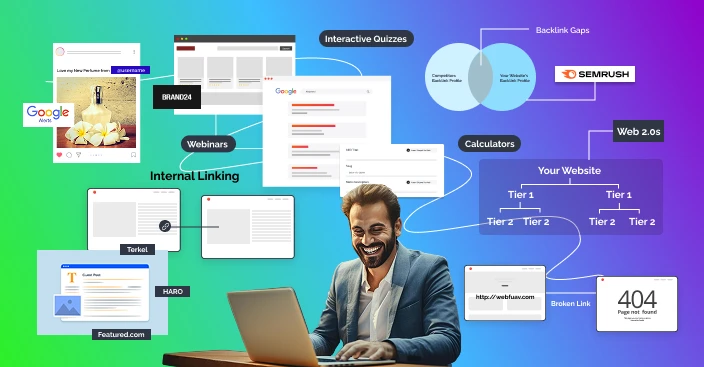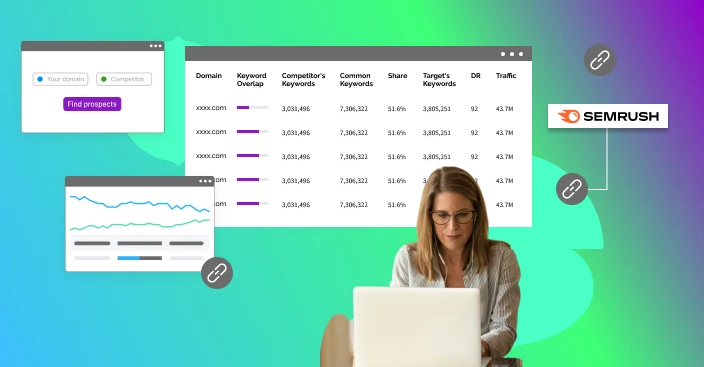7 Link Building Tactics for eCommerce SEO Success

Getting to the top of search engine results is what every marketer strives. But, what is the point of having a high search engine ranking if your web page is not getting any traffic out of it?
Climbing the search engine ranks is something every eCommerce business aims for. But getting a high position on Google is only half the battle. What really matters is attracting the right visitors who are likely to become customers.
If your website isn’t getting the traffic or conversions you expected, your SEO strategy might be missing a key ingredient: link building.
Links do more than just boost your rankings — they help build trust, bring in relevant traffic, and improve overall visibility. When done right, link building can make a real difference in your online growth.
In this blog, we’ll explore seven effective link building tactics tailored for eCommerce websites that want to grow their audience and improve their search engine performance.
1. Strengthen Internal Linking with AI-based Clustering
In simple words, internal links are links to other web pages on a domain. Internal link building works perfectly to improve SEO ranking as well as traffic because it makes it easy for Google’s crawler bots, as well as users, find related content effortlessly.
Think of internal linking as a way of letting your readers find more information related to a topic they are currently reading.
By allowing readers to explore information on a single topic from your website, you increase the overall dwell time for your website.
Use AI-powered internal linking tools (like LinkWhisper or SurferSEO) to build topic clusters and auto-suggest link opportunities. Google’s SGE (Search Generative Experience) in 2026 now rewards semantically related internal links more than ever.

2. Leverage Brand Mentions (Linked & Unlinked)
Brand mentions, whether they link or not, signal authority and trust. In 2026, Google’s Helpful Content algorithm 3.0 is believed to evaluate contextual brand citations, even if no link is present.
Tip: Use tools like Mention, Brand24, or Google Alerts to identify unlinked brand mentions and politely request attribution.
3. Reverse Engineer Competitor Backlinks with Link Gap Analysis
Don’t just follow your competitor’s links,do a link gap analysis using tools like Semrush, SE Ranking, or Ahrefs. Look for:
- Referring domains they have but you don’t
- High-authority blogs, PR sites, or industry roundups where your competitors are featured
Brands using link gap strategies report 3x faster ranking of their product category pages (Moz, 2025).
4. Use High-DA Web 2.0s as Tiered Link Sources
Web 2.0 isn’t dead. Use it strategically:
- Tier 1: Medium, LinkedIn Articles, Substack
- Tier 2: Quora Answers, Reddit Posts, Tumblr
Add video or interactive media to enhance link quality.
Tiered linking through Web 2.0 improved ranking velocity by 22% in long-tail keywords (Search Engine Journal, 2025)
5. Repurpose Content into Interactive Assets
Your content in the form of a blog, a guest blog, or a press release can be converted into many other forms to improve search engine ranking as well as traffic. In inbound marketing terms, it is called content repurposing.

Move beyond static repurposing. Repurpose blog posts into:
- Interactive Quizzes (e.g., “Which eCommerce Platform Suits You?”)
- Calculators (e.g., shipping costs, profit margins)
- Webinars or Virtual Demos
Interactive content shared on LinkedIn has 38% higher backlink acquisition potential than standard PDFs or static blogs.
6. Contribute Guest Content to Niche Communities
Guest Posting is the most effective backlink strategy for gaining links from content-based authority websites. Guest blogging sites provide valuable information to Google bots and visitors. For the best industry-wise guest blogging website, use the guest posting search query.
Instead of generic “write for us” posts, target industry-specific editorial platforms, newsletters, or ecommerce marketing podcasts.
Use tools like Terkel, HARO (now Connectively), or Featured.com to pitch niche guest content.
Write a well-researched article related to your industry, product launches, information, news, general tips, and how-to. Ensure the anchor text is relevant to the content and appears generic.

7. Broken Link Building with Visual Content
Identify broken links that point to outdated product pages, tools, or blog posts within your niche. Offer custom infographics or updated blog posts as replacements.
Use Check My Links (Chrome Extension), Screaming Frog, or Ahrefs.
Example: If you find a broken link to an old “eCommerce Trends 2022” post, offer your updated 2026 trends with a better design and updated insights.
BONUS TIP- Build Partnerships with Influencers for Linkable Assets
In 2026, influencer partnerships aren’t just about social media. Collaborate with micro-influencers to co-create downloadable guides, templates, or stats reports that are highly shareable and linkable. Co-branded content sees 67% more backlink acquisition than solo content.
Pricing/Investment Note
Link building has become more strategic (and expensive). Here’s a quick cost outline for 2025-2026:
- Guest post on niche site: $100–$600/post
- High-authority outreach backlinks: $400–$1,500/link
- AI-driven link audit tools: $49–$299/month
- Freelance link builder: $15–$50/hr (Upwork, Fiverr Pro)

Winding It Up
As Google evolves toward experience-driven and contextual search, e-commerce brands must build more than just backlinks; they must also establish relevance, trust, and topical authority.
By combining smart internal linking, data-backed guest contributions, repurposed assets, and consistent competitor analysis, your brand can create a sustainable link profile that not only ranks but converts.
Focus on value-first links, not vanity metrics, and you’ll unlock SEO-driven revenue growth in 2026 and beyond. Connect with an SEO expert to ensure better visibility and linking
FAQs
 What is link building in SEO?
What is link building in SEO?
Link building means getting other websites to link to your online store or blog. These links act like “votes of trust” that tell Google your site is valuable and worth ranking higher.
 Why is link building important for eCommerce websites?
Why is link building important for eCommerce websites?
For eCommerce, link building helps your store show up higher on Google, brings in more visitors, builds trust in your brand, and can increase sales by attracting the right audience.
 What are internal links, and how do they help SEO?
What are internal links, and how do they help SEO?
Internal links are links that connect one page of your website to another page on the same site. They help visitors (and Google bots) find related products or blogs easily, which improves rankings and keeps people on your site longer.
 What are brand mentions, and why do they matter?
What are brand mentions, and why do they matter?
A brand mention is when someone talks about your store or products online. Even if they don’t link directly to your site, it still signals trust and authority. If the mention is unlinked, you can reach out and ask for a link.
 How do I find my competitors’ backlinks?
How do I find my competitors’ backlinks?
You can use SEO tools like Ahrefs, SEMrush, or SE Ranking to see where your competitors are getting their backlinks. Then, you can target the same websites to get links for your store.
 Are Web 2.0 links still useful in 2026?
Are Web 2.0 links still useful in 2026?
Yes, if used strategically. Platforms like Medium, LinkedIn, and Substack can give quality Tier 1 links, while Quora or Reddit can provide supporting Tier 2 links. These help boost your overall link profile.


